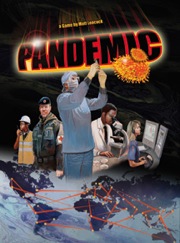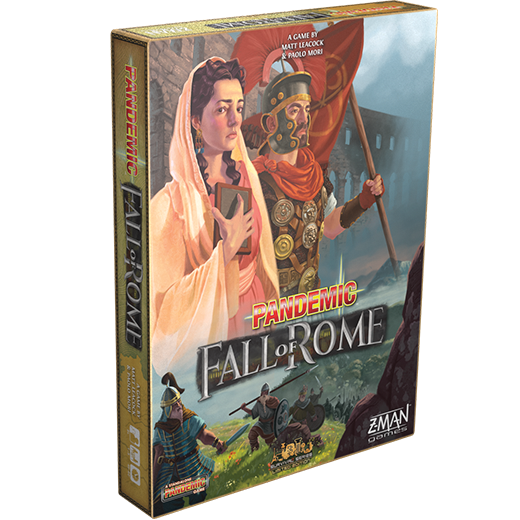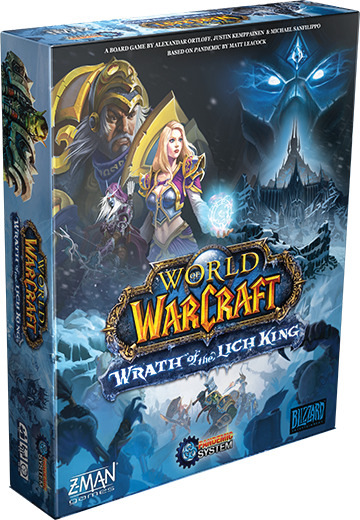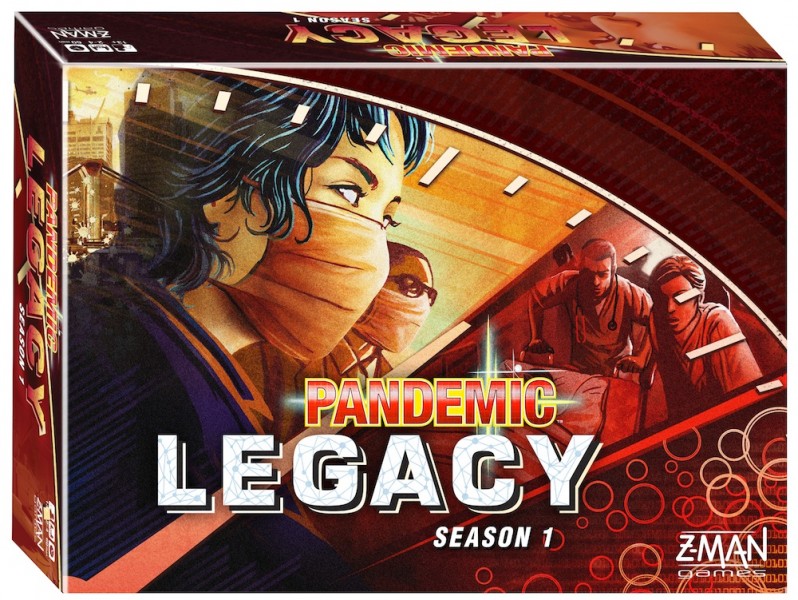Pandemic remains one of the biggest board games years after its release, its status as a fully cooperative gateway game with a clear goal—no abstract victory points here—and an impulse-buy price point means it’s an easy recommend.
If you’ve never given the disease duel a try, here’s a brief table-set before we get to the good stuff: In Pandemic and its spinoffs, all players work together to stop a threat by collecting color-coded cards, performing special actions, and moving about a dense board. An ‘Epidemic’ deck supplies those cards, along with disaster, bringing about a loss if you can’t destroy the diseases before it runs out. Hand management, action optimization, and necessary teamwork drive the Pandemic puzzle.
puzzle.
It’s also a formula that lends itself to re-themes. The core loop, drawing cards and praying you don’t find yourself top-decking disaster while clearing counters from the board, maintains its addictive simplicity no matter the setting.
That setting is what we’re here to talk about. Below, you’ll find Pandemic twisted into all sorts of new worlds. Whether you’ve never tried Pandemic games before or want something deeper than diseases to cure, read on.
Pandemic in the Past
Take the Roman Empire, for example. Here you have a gluttonous realm getting assaulted by barbarians from all sides. In Pandemic: Fall of Rome, you’re not curing diseases but spearing pillaging warriors, your retinue not one of scientists but soldiers, emperors, and the occasional magister. Actions feel familiar—you’re still jumping between cities via marching or sailing—but a few differences make Fall of Rome feel unique.
The enemy and how they’re beaten is the prime example. You’re not whisking away contagions with vaccines, but booting barbarians from the realm. They won’t go away if you wave a vial in their faces or soak them in soap, instead you’ll have to do what Rome was pretty darn good at: battling. This isn’t a sure thing, but instead plays out with some solid dice-chucking, bolstered by your legions (that you might lose in the battle). Adding chance to a tight game like Pandemic might seem fraught or frustrating, but Fall of Rome layers in the chance with powerful character abilities triggered by those same dice.
In other words, you’re likely to find something to cheer for when you roll.
 The dice bring a side advantage addressing one of Pandemic’s biggest concerns: quarterbacking, where a single player can math out everyone’s turns, guiding the optimal play and turning the game into a series of mindless actions. The dice introduce unpredictability, forcing players to adjust on the fly. Or you can embrace quarterbacking by jumping into the solo mode, with every decision yours alone, Emperor.
The dice bring a side advantage addressing one of Pandemic’s biggest concerns: quarterbacking, where a single player can math out everyone’s turns, guiding the optimal play and turning the game into a series of mindless actions. The dice introduce unpredictability, forcing players to adjust on the fly. Or you can embrace quarterbacking by jumping into the solo mode, with every decision yours alone, Emperor.
Pandemic: Iberia retains the disease fighting focus of the original but settles you a few centuries back on the Iberian peninsula. The game has fewer changes to the original Pandemic’s co-op slurry, adding a couple nifty actions and upping the production quality to beautiful levels.
First and foremost, being stuck in the past, you’re not able to fly around the map as in Pandemic. Instead, your characters can build railroads, connecting cities and allowing folks to zip along a given rail from one end to the other in a single action. You’re also able to purify the water where you’re at, essentially adding a buffer against new diseases planting their nefarious cubes in your beloved cities.
There’s more tweaks on the margins, but Iberia represents a mild evolution on Pandemic’s design, a great choice for players who love Pandemic but want more variety, a new puzzle to solve, or have a friend with a copy and don’t want to buy the same game.
Sci-fi And Fantasy Pandemic
Then again, if you don’t want the same Pandemic, why not leave Earth entirely and go into the realm of big IPs!
World of Warcraft might be known better for its digital versions, but World of Warcraft: Wrath of the Lich King deserves a look too, if only because hordes of undead to battle are so much more fun than diseases. You won’t be playing a scientist or a ho-hum medic, but instead going green as Thrall or drawing back your bow as Sylvanas. Staving off the undead is only part of the game, too, as quests and carving your way to the Lich King himself loom. Much more than a simple re-skin, Wrath of the Lich King brings the Pandemic co-op puzzle to—
Okay, look, a quick glance at Wrath of the Lich King’s going to tell you whether this is your game, or a perfect purchase for a pal. If you stomped orcs in Warcraft’s 90’s era glory days and want a quick-playing co-op to restore those glorious memories? Here you go. If you’ve a level 70 Death Knight that likes to roam Icecrown hunting hapless Alliance druids, this is a neat way to take the same scene to your tabletop (not the druids, but the undead. They’re all hapless).
If you prefer starships to staves, Star Wars: The Clone Wars gets you in on the battle-droid bashing you never knew you craved. Set during the Clone Wars (duh), Pandemic’s diseases get the mech treatment, turning into invading swarms of Roger, Rogers that must be dispatched by your Jedi. Like Wrath of the Lich King, you’ll use battle dice, complete quests (missions, here), and sling dice all while trying to keep planets from falling to invasions.
Pandemic’s diseases get the mech treatment, turning into invading swarms of Roger, Rogers that must be dispatched by your Jedi. Like Wrath of the Lich King, you’ll use battle dice, complete quests (missions, here), and sling dice all while trying to keep planets from falling to invasions.
The Clone Wars throws variance into its battle system by allowing you to add squad cards to your hand, exhausting them to boost die rolls. If the Force isn’t with you, you’ll have to burn other cards to keep your Jedi from going all ghosty. Like Fall of Rome, the reliance on dice rolls doesn’t break the game, but does add enough randomness to keep things unpredictable.
Villains are another addition, changing the antagonist from a nameless deck to, like the Lich King, a specific evildoer in need of a swift demise. These head honchos serve as your disease deck, delivering devastation, sending their subordinates, and spawning droids to mess with your plans. As with all Pandemic games, you’ll want to play at different difficulty levels, finding a satisfying challenge without letting the Dark Side win.
Unless, you know, you want to. #teamdarth
Campaigns, Pandemic Style
Pandemic’s core game might appeal just fine, though, so if you want to stick with its modern-era medicine, then considering roping in your game night group for a disease-driven odyssey unlike anything you’ve played before. Well, okay, it’s still Pandemic but with a Story!
The three (so far) legacy editions of Pandemic explore different eras, mingling envelope-driven chapters with persistent board changes based on how you play the  game. Let disease ravage a city, and that spot might be hard to enter (or impossible) as you go along. You’ll be able to draw a line from start to finish as your adventure continues, reliving, with winces or grins, the games where Europe clung on or North America succumbed to an ill-timed epidemic. The surprises buried in these games—I’d recommend starting with Season 1—will make game night an appointment worth keeping, and none bump the difficulty up so far folks who like Pandemic won’t be able to stick with it.
game. Let disease ravage a city, and that spot might be hard to enter (or impossible) as you go along. You’ll be able to draw a line from start to finish as your adventure continues, reliving, with winces or grins, the games where Europe clung on or North America succumbed to an ill-timed epidemic. The surprises buried in these games—I’d recommend starting with Season 1—will make game night an appointment worth keeping, and none bump the difficulty up so far folks who like Pandemic won’t be able to stick with it.
That said, normal campaign caveats apply: Pandemic: Legacy is best played with four committed pals, preferably ones who won’t drop out halfway. You’ll also be altering the board as you go, ending up with a custom Pandemic game at the end, but this is largely a one-time onder.
Pandemic, now with Dice!
And now we leave behind the bigger board for more dice, more chucking, and more wild entertainment. Pandemic: The Cure stuffs a lot of action into its small box, changing up the card deck for dice and putting a Yahtzee-esque reroll mechanic into your every turn. It’s less serious, shorter, but perfect for filler minutes before game night gets going.
game night gets going.
At a price cheaper than a movie ticket, Pandemic: The Cure eliminates any alpha gaming problem, brings wild luck and laughter, and is small enough to take with you anywhere. Just like a real disease!
It’s a Wide, Infected World Out There
Pandemic and its variants—we didn’t even get to the Cthulhu version or the stake-spiking Hot Zone expansions—give a gamer’s choice buffet. If you’ve never touched Pandemic before, trying the original is still your best bet to get a feel for the system, and odds are someone you know has a copy. From there, pick your favorite setting, be it Rome, Warcraft, or the Cold War in Pandemic Legacy: Season Zero.
With a core loop this good, you can’t go wrong.
